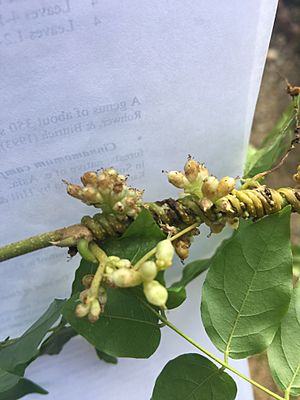Compact dodder facts for kids
Quick facts for kids Compact dodder |
|
|---|---|
 |
|
| Scientific classification | |
| Genus: |
Cuscuta
|
| Species: |
compacta
|
Cuscuta compacta, also known as the compact dodder, is a special kind of plant. It's a parasitic plant, which means it gets its food and water from other plants. This dodder loves to attach itself to woody plants like trees and bushes. You can find it in the eastern and central parts of the USA, eastern Canada, and Mexico. It's quite common in places like southern Alabama.
Contents
What is the Compact Dodder?
The compact dodder is also called the flower love vine. It's a plant that doesn't grow roots into the ground. Instead, it wraps its yellowish stems around other plants. This allows it to take all the nutrients it needs from its host.
How Does it Look?
The compact dodder has a yellowish stem that looks like a thin string. This stem wraps tightly around its host plant.
Its flowers are very small. They usually grow in groups of four or five. Each flower is shaped like a tiny tube. They are about 5 millimeters (0.2 inches) long. After the flowers, the plant forms small, tube-shaped seed pods. The seeds inside are brown and about 2 millimeters (0.08 inches) long.
Where Does it Live?
You can find Cuscuta compacta across many parts of North America. This includes the lower 48 states of the USA and Canada. Other types of dodder plants are found all over the world.
The compact dodder is often seen wrapped around its host plants from July to November. It likes to live in wet places. These include forests near streams, marshes, and swamps. It can attach to many different kinds of plants. However, it especially likes woody plants.
How it Gets Food
Cuscuta compacta is a heterotrophic parasitic plant. This means it cannot make its own food. Instead, it attaches itself to other plants and takes their nutrients.
When a compact dodder seed starts to grow, it sends out a slender shoot. This shoot doesn't grow roots into the ground. Instead, it searches for a host plant. The shoot bends and moves until it finds a plant to attach to. Once it's attached, it forms tiny suckers. These suckers go into the host plant to steal food and water.
In a lab, one dodder plant can attach to many hosts at once. But in nature, it seems to pick its hosts more carefully.
How Seeds Grow
Germination is when a seed starts to grow into a plant. For Cuscuta compacta, this happens after the seed soaks up water. The tiny plant inside the seed then uses stored food to grow. It sends out a small root-like part towards the ground.
For the compact dodder to germinate, the temperature needs to be just right. It prefers temperatures around 22 to 23 degrees Celsius (71.6 to 73.4 degrees Fahrenheit).
Why it Matters to Farmers
Sometimes, Cuscuta compacta can be a problem for farmers. In North Carolina, blueberry growers have reported it as a pest. This is because the dodder loves to attach to blueberry bushes.
The way blueberry bushes grow, with many shoots near the ground, might make it easier for the dodder to attach. The seeds of the dodder can spread in ditches near wet areas. Birds might also help spread the seeds.
What Plants Does it Attach To?
The compact dodder can use many different plants as hosts. It especially likes woody or semi-woody plants. Here are some of the plants it has been found on:
- Acer (maple trees)
- Alnus (alders)
- Vaccinium (blueberry bushes)
- Smilax (greenbriers)
- Sassafras (sassafras trees)
- And many others like Hypericum, Ilex, and Viburnum.

